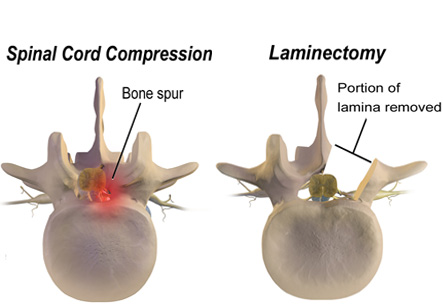Laminectomy
Introduction
Laminectomy is a surgery to remove the lamina, part of the bone that makes up a vertebra, or bone spurs in your back. The procedure is used to relieve the pressure of bones on the spinal nerves inside the spinal canal. It opens up the spinal canal reducing the pressure on the nerves. It can be done along with other procedures like diskectomy, foraminotomy, and spinal fusion.
Laminectomy often provides full or partial relief of symptoms in spinal stenosis patients.
This surgery is done most commonly for the patients of spinal stenosis and nerve compression thereby. Indications for laminectomy include access to a tumor or other mass lesion situated in or around the spinal cord, and a step in correct the shape of the vertebral column for treating a spinal deformity such as kyphosis.
Iran ranks among the top 10 countries in orthopedics and Iranian surgeons perform high quality orthopedic surgeries at highly affordable prices

Symptoms of nerve compression are:
1. Pain and numbness in both the legs.
2. Weakness and heaviness in legs or buttocks.
3. Problems in emptying or controlling the bladder.
4. Worsening of symptoms on standing or walking.
These symptoms worsen over time and if they become severe and start to affect the daily life, this surgery can benefit the patient.
Before the surgery:
1. A proper history, examination and few lab tests and scans are done to determine the general health.
2. An MRI is the procedure of choice for the diagnosis of spinal stenosis. The scans are very important for the surgery.
3. Patient should stop anti-inflammatory drugs like aspirin at least a week before surgery.
4. Medications being taken for other conditions like diabetes, heart disease, blood pressure should be continued with advice from the treating doctor.
5. History of smoking or alcohol drinking should be told to the surgeon. Smoking should be stopped if possible as it interferes with the wound healing.
6. Recent history of cough, cold, fever, viral infections, or other illnesses should be informed to the surgeon.
7. Patient is not allowed to eat or drink anything at least 8 to 12 hours before surgery except essential medicines with sips of water.
Procedure:
1. Position of the patient for the surgery is face down on the operating table. Incision is usually in the midline of the back.
2. There are two methods of laminectomy. In conventional open laminectomy, the posterior spinal ligament, the spinous process, and facet joint are all excised by the surgeon. Removal of these structuresinvolves cutting the various muscles of the back which attach to them. In Laminectomy as a minimal spinal surgery procedure, the muscles and ligaments are pushed to a side and not cut. This procedure entails less removal of bone than the open method. A surgical microscope can be used to view the inside structures.
3. Any bone spurs, fragments or other tissues in the spinal canal are also removed.
4. A foraminotomy can also be done which still widens the space for the nerve roots in the spinal canal.
5. Spinal fusion can be done for more stability of the spine.
6. All the retracted layers are closed over the spine by suturing and the wound is covered by giving dressing.
This Surgery takes around 1 – 3 hours.
After the procedure, patient is asked to get up from bed and walk around as soon as the effect of anesthesia wears off. In spinal fusion patients, this is not done. Most of the patients can go home 1 – 3 days after the surgery.
Risks involved in this procedure:
1. Risks for any surgery are blood loss, infections, blood clots travelling to lungs, drug allergy, breathing problems and cardiovascular complications.
2. Risks for spine surgery are:
• Infection in surgical site
• Spinal nerve damage causing weakness, pain and loss of sensations.
• Failure of surgery
• Reversion of symptoms
Prognosis:
The success of the laminectomy depends upon various factors like the indication for the operation, proper patient selection and technical skill of the surgeon.
Laminectomy often provides full or partial relief of symptoms in spinal stenosis patients. In spinal fusion with laminectomy, the spinal columns above or below the level can develop problems in future.